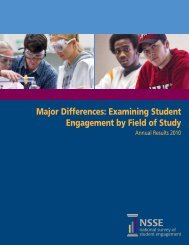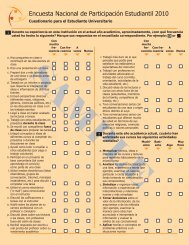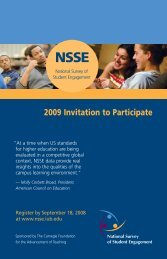Conceptual Framework and Overview of Psychometric Properties
Conceptual Framework and Overview of Psychometric Properties
Conceptual Framework and Overview of Psychometric Properties
You also want an ePaper? Increase the reach of your titles
YUMPU automatically turns print PDFs into web optimized ePapers that Google loves.
Reading, Writing, <strong>and</strong> Other EducationalProgram CharacteristicsSome additional items address other importantaspects <strong>of</strong> how students spend their time <strong>and</strong>what the institution asks them to do, whichdirectly <strong>and</strong> indirectly affect theirengagement. The results discussed in thissection are not presented in a table but areavailable from the NSSE website. The fiveitems about the extent to which the institutionemphasizes different kinds <strong>of</strong> mental activitiesrepresent some <strong>of</strong> the skills in Bloom=s(1956) taxonomy <strong>of</strong> educational objectives.The st<strong>and</strong>ardized alpha for these items is .70when the lowest order mental function item,memorization, is included. However, thealpha jumps to .80 after deleting thememorization item. This set <strong>of</strong> items is amongthe best predictors <strong>of</strong> self-reported gains,suggesting that the items are reliablyestimating the degree to which the institutionis challenging students to perform higherorder intellectual tasks.Patterns <strong>of</strong> correlations among these items areconsistent with what one would expect. Forexample, the item related to the number <strong>of</strong>hours spent preparing for class is positivelyrelated to several questions surroundingacademic rigor such as the number <strong>of</strong> assignedcourse readings (.25), coursework emphasison analyzing ideas <strong>and</strong> theories (.16) <strong>and</strong>synthesizing information <strong>and</strong> experiences(.16), the number <strong>of</strong> mid-sized (5-19 pages)written papers (.15), <strong>and</strong> the challengingnature <strong>of</strong> exams (.21). Likewise, the number<strong>of</strong> assigned readings is predictably related tothe number <strong>of</strong> small (.24) <strong>and</strong> mid-sized (.29)papers written. Interestingly, the quality <strong>of</strong>academic advising is positively correlatedwith the four higher order mental activities,analyzing (.15), synthesizing (.17), evaluating(.15), <strong>and</strong> applying (.17), <strong>and</strong> is alsopositively related to the challenging nature <strong>of</strong>examinations (.20).The set <strong>of</strong> educational program experiences(e.g., internships, study abroad, communityservice, working with a faculty member on aresearch project) have an alpha <strong>of</strong> .52.Working on a research project with a facultymember is positively related to independentstudy (.27), culminating senior experiences(.25), <strong>and</strong> writing papers <strong>of</strong> 20 pages or more(.15). Also, students who had taken foreignlanguage coursework were more likely tostudy abroad (.24). It=s worth mentioning thatthe national College Student ExperiencesQuestionnaire database shows that theproportion <strong>of</strong> students saying they haveworked on research with a faculty member hasactually increased since the late 1980s,suggesting that collaboration on research maybe increasingly viewed <strong>and</strong> used as adesirable, pedagogically effective strategy(Kuh & Siegel, 2000; Kuh, Vesper, Connolly,& Pace, 1997).Finally, the time usage items split into twosets <strong>of</strong> activities, three that are positivelycorrelated with other aspects <strong>of</strong> engagement<strong>and</strong> educational <strong>and</strong> personal gains (academicpreparation, extracurricular activities, work oncampus) <strong>and</strong> three items that are either notcorrelated or are negatively associated withengagement (socializing, work <strong>of</strong>f campus,caring for dependents). Less than 1% <strong>of</strong> fulltimestudents reported a total <strong>of</strong> more than100 hours across all six time allocationcategories. Three quarters <strong>of</strong> all studentsreported spending an average <strong>of</strong> between 35<strong>and</strong> 80 hours a week engaged in theseactivities plus attending class. Assuming thatfull-time students are in class about 15 hoursper week <strong>and</strong> sleep another 55 hours or so aweek, the range <strong>of</strong> 105 to 150 hours taken upin all these activities out <strong>of</strong> a168-hour week appears reasonable.A few <strong>of</strong> these items have out-<strong>of</strong>-range butexplainable skewness <strong>and</strong> kurtosis indicators.They include the number <strong>of</strong> hours spentworking on campus (72% work five or fewerhours per week), the number <strong>of</strong> papers <strong>of</strong> 20<strong>Framework</strong> & <strong>Psychometric</strong> <strong>Properties</strong>Page 9 <strong>of</strong> 26



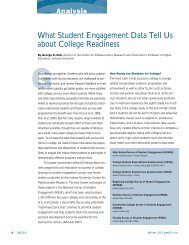

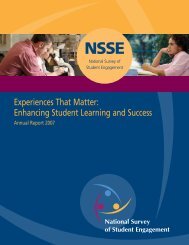
![Cuestionario para el Estudiante Universitarioâ[consent] - NSSE](https://img.yumpu.com/41728892/1/190x245/cuestionario-para-el-estudiante-universitarioaconsent-nsse.jpg?quality=85)
